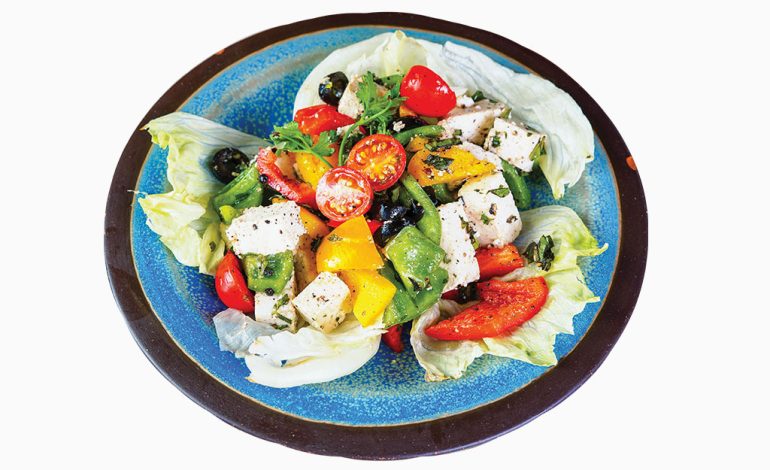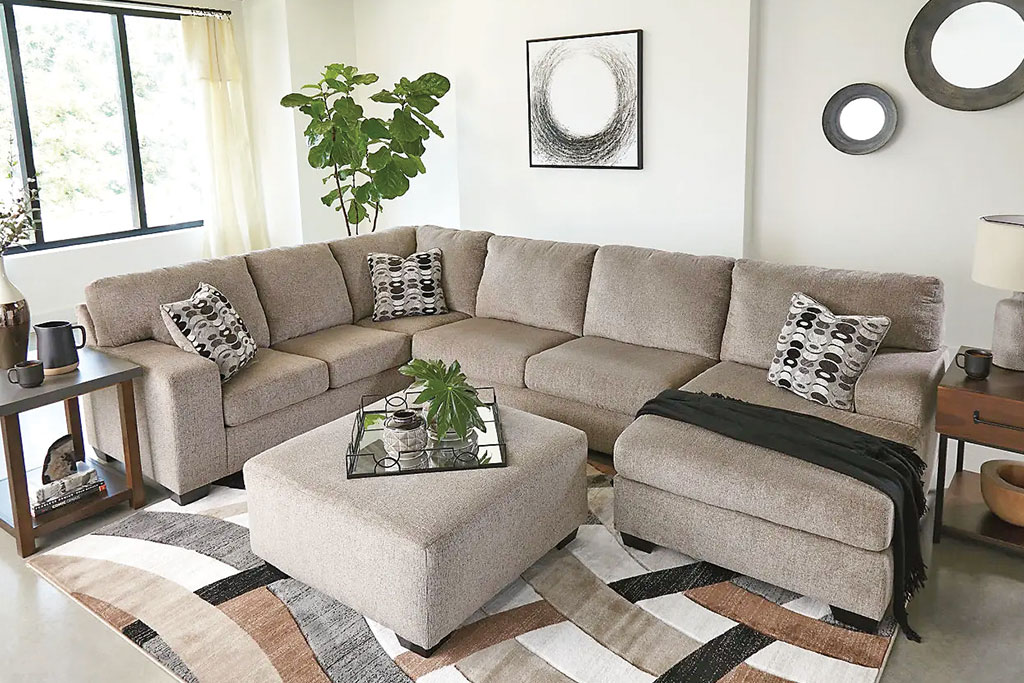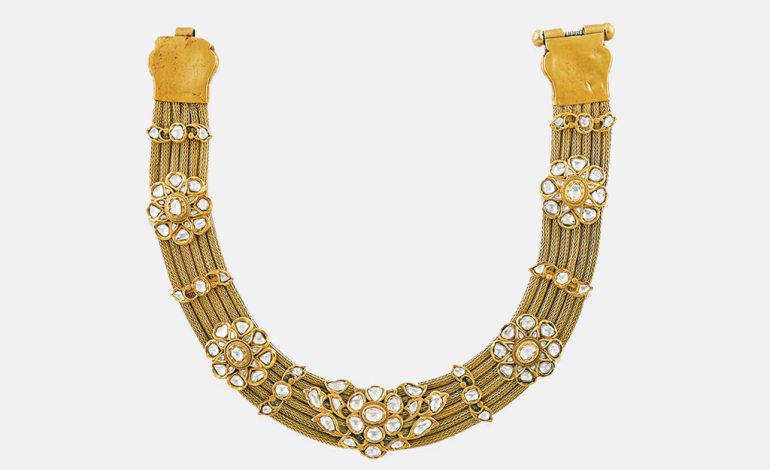
Symbols Of Regalia
The heritage of traditional Rajasthani jewellery traces back to several centuries. The revered legacy of illustrious and elaborate designs executed with meticulous craftsmanship bears witness to the royal grandeur of Rajput dynasties. There are several styles that are hallmarks of traditional Rajasthani jewellery. The Balewda necklace consists of flat gold chains, often set with diamonds held together with bejeweled clasps. Such necklaces were typically worn by the Jain and Hindu mercantile classes in the bygone era, especially in Rajasthan. Patlas are traditional Meenakari resin work bangles with detailed work in kundan, pearl, and other precious stones. Gajra kadas is set in gold with clusters of seed pearls bunched in a floral style. The contrast of gemstones with detailed enameling renders these bangles a beautiful polychromatic effect. Pioneered by the craftsmen of Mewar in Rajasthan, Gorkhu gold bangles consist of hammered gold balls on columns, applied to an arched jaali rim. A convex or bell-shaped pendant set with gemstones known as Borla is a traditional head ornament worn by women in the region. An arm ornament from the region called Bajubandh is designed as a tabeez. Decorated with fine enamel detailing in a foliate pattern, it is strung and secured with a traditional Rajasthani chedia.
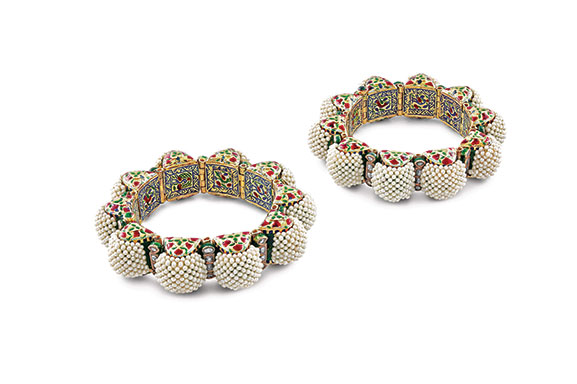
Pearl patlas
This revered tradition is also a testimony to the great cultural confluence in Rajasthan during the Mughal era, which came to be a period that provided great prominence for its jewellery. Ardent lovers of gems and jewellery, the Mughal rulers blended the indigenous Rajputana forms with Persian influences leading to the emergence of several techniques which were then perfected in the region. One of these was enamelling or minakari, which is a unique combinationof enamel pigments and precious metals. Minakari is known for its celestial beauty depicting motifs including flowers, birds, plants, and leaves in vivid hues. The use of enamelling in Rajasthan is said to have originated with Maharaja Man Singh of Mewar, who was a friend of Emperor Akbar and is said to have brought five Sikh enamel workers from Lahore to Jaipur. The first known reference to enamelling is found in Aini-Akbari written by Emperor Akbar’s court historian Abu’l Fazl in the 16th century. “The minakar or enameller works on cups, flagons, rings, and other articles with gold and silver. He polishes his delicate enamels separately in various colours, sets them in suitable places, and puts them on the fire. This is done several times,” wrote Abu’l Fazl. The prominence of enamel jewellery continued to grow through the superseding eras and the region became the most prominent centre for minakari jewellery. One such evidence of its eminence in the 20th century is found in the 1909 published book, The Journal of Indian Art written by Thomas Holbein Hendley. A British medical officer in Rajputana state, Hendley was also an ardent admirer of Indian art.
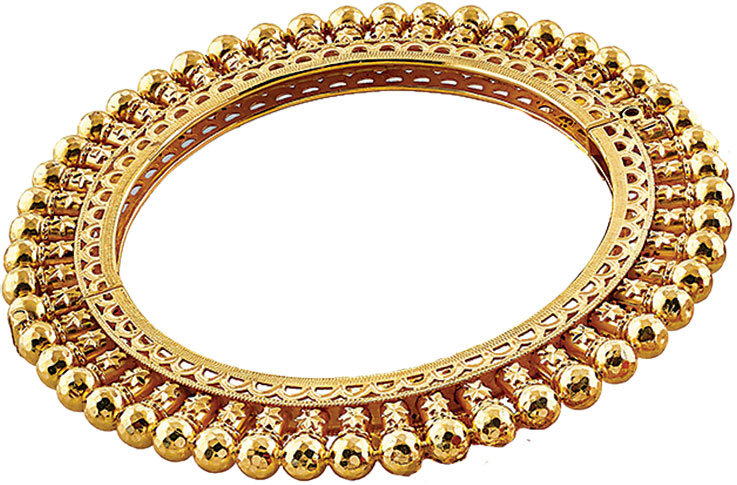
Gold Gokhru Bangles
“It would be impossible to give a complete account of Rajputana jewellery without adverting to the manufacture of enamel on gold for which Jaipur is especially renowned. When a rich patron, whether an Indian or European, wishes to obtain a work of art in Indian enamel, it is only Jaipur work that he desires to possess,” Hendley writes in the book highlighting the importance of Rajasthani enamel jewellery. The Mughal era bestowed several other techniques that were mastered by the jewellery craftsmen of Rajasthan. Deriving its name from the term jad which means to embed, jadau jewellery entails embedding precious gemstones such as diamonds, pearls, emeralds, and rubies in gold without the use of any adhesive. As the technique was perfected by the craftsmen, the area came to be an important hub of jadau jewellery. A close-fitting necklace called the Jadau Aadiya takes its name from the word Aadiya meaning ‘wealthy’ and is synonymous with traditional Rajasthani jewellery. Another beautiful gift from this cultural crossbreeding is polka jewellery. Incepted during the Mughal reign, the technique of hand-crafting uncut diamonds into fine jewellery reached its zenith in Rajasthan and became a speciality of Bikaner. The extraordinary confluence of art, culture, and master craftsmanship, Rajasthani jewellery continues to be celebrated and coveted by jewellery connoisseurs across the world.
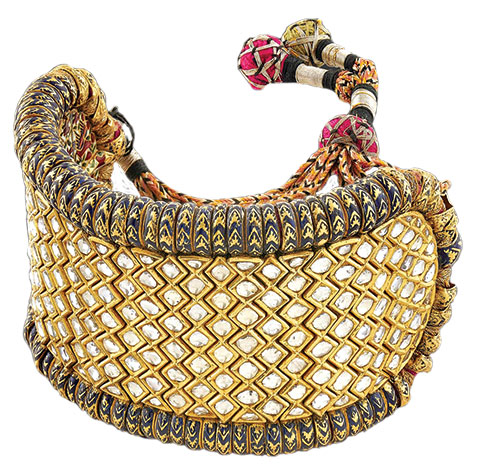
Jadau Bajubandah

